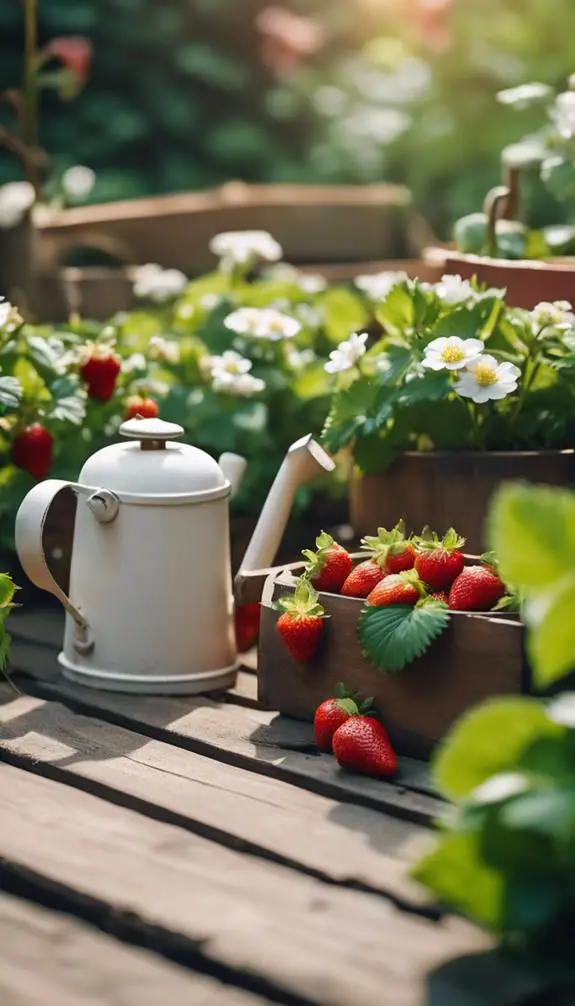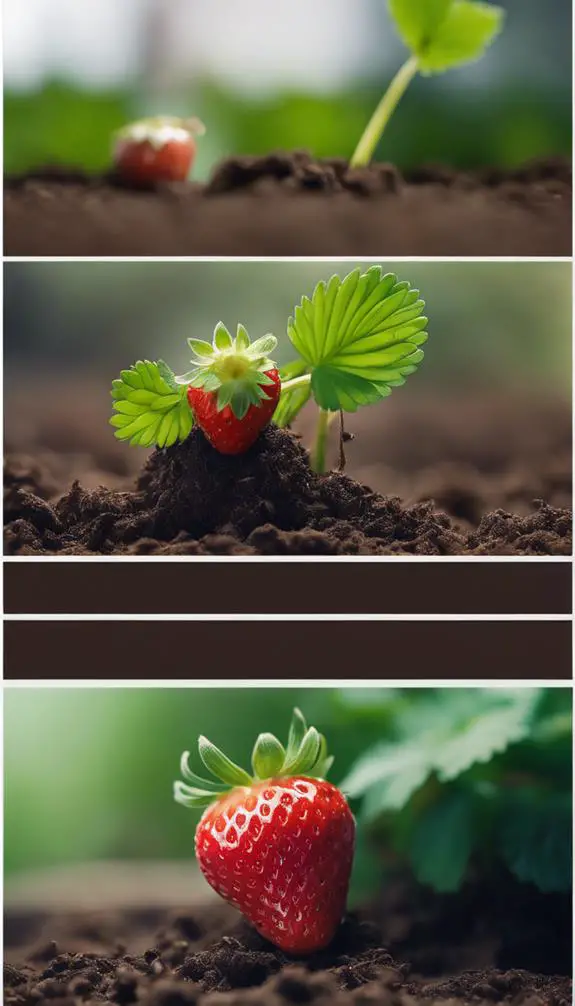You're probably throwing away a valuable resource every time you chop up a sweet pepper for dinner, but what if you could turn those scraps into a brand new plant? It's easier than you think. By selecting the right pepper sections, preparing them properly, and providing ideal growing conditions, you can coax a new sweet pepper plant out of what would otherwise be trash. But where do you even start? You'll need to know how to dry the cuttings, fertilize the new growth, and eventually transplant it into a larger space.
Summary
- Select healthy, disease-free pepper scraps with desirable traits like flavor, texture, and color, and choose sections with at least two nodes.
- Cut pepper scraps into 1-2 inch sections, making sure each section contains at least one node, and cut at a 45-degree angle to promote healthy root growth.
- Dry the pepper cutting to remove excess moisture and prevent rot, using methods like air drying or desiccants like silica gel.
- Plant the pepper cutting in a well-draining, sterile rooting medium, burying the node and securing the cutting, and provide adequate light, temperature, and humidity.
- Water consistently, monitor moisture levels, and provide 12-14 hours of light per day to encourage healthy growth and fruit production.
Choosing the Right Pepper Scraps

Your sweet pepper garden's success hinges on selecting the right pepper scraps, as these will form the foundation of your crop.
You'll want to choose scraps from healthy, disease-free peppers with desirable traits like flavor, texture, and color. Consider the pepper varieties you want to grow, as some are better suited for scraps than others.
For example, sweet bell peppers and cubanelle peppers are ideal for scrap selection, while hot peppers like jalapenos may not produce consistent results.
When selecting scraps, look for sections with at least two nodes, as these will have a higher success rate of rooting. Avoid taking scraps from weak or spindly areas of the pepper, as these may not produce strong, healthy plants.
Preparing the Cutting Tool

Now that you've selected the perfect pepper scraps, it's time to prepare your cutting tool.
For ideal results, choose a sharp, clean knife or pruning scissors specifically designed for cutting plant material. Dull tools can crush or tear the delicate pepper tissues, leading to poor growth.
Select a tool that feels comfortable in your hand, allowing for precise control and smooth cutting techniques. Consider the size and shape of the scraps, and adjust your tool selection accordingly.
A smaller tool may be necessary for intricate cuts, while a larger tool can handle thicker scraps. With your cutting tool ready, you're one step closer to successfully growing sweet peppers from scraps.
Cutting the Pepper Scrap
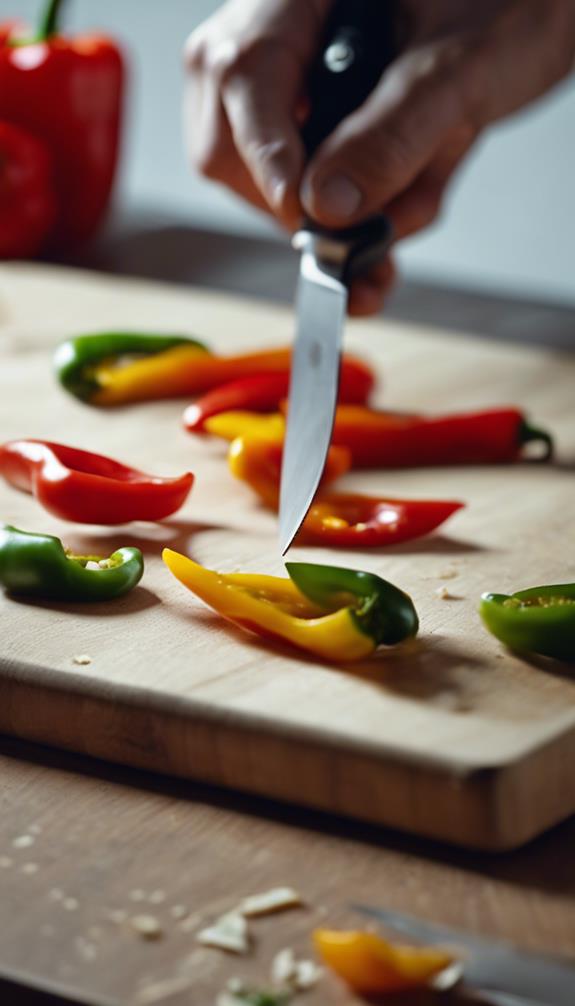
You hold the cutting tool, poised and ready to make the first snip.
Now, it's time to carefully cut the pepper scrap into sections, keeping in mind the pepper anatomy.
Identify the nodes, where the leaves meet the stem, as these will be the points from which new roots will grow.
Using precise cutting techniques, snip the pepper scrap into 1-2 inch sections, making sure each section contains at least one node.
Cut just above a node, at a 45-degree angle, to promote healthy root growth.
Avoid crushing or tearing the stem, as this can reduce the chances of successful propagation.
Removing Seeds and White Bits
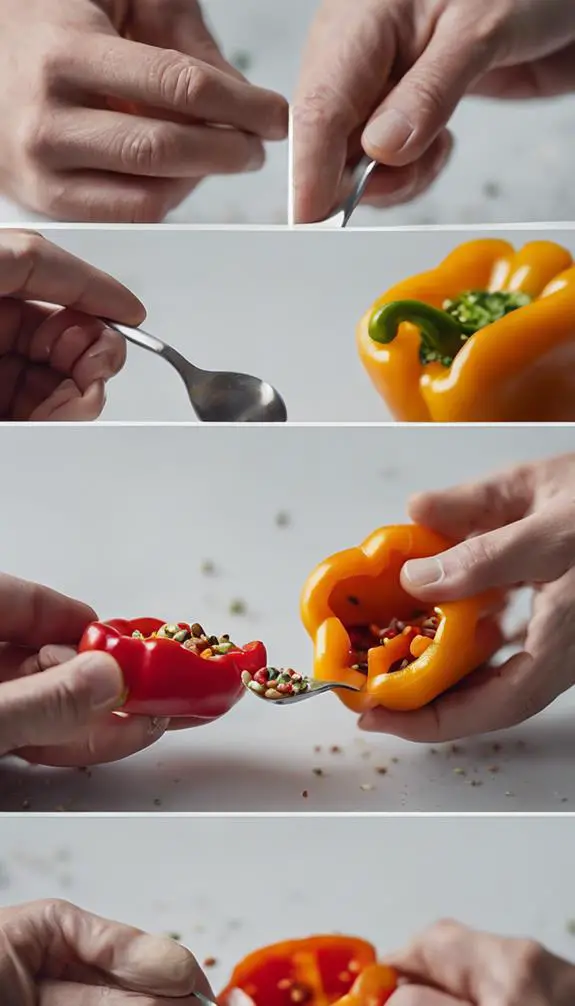
You'll want to remove the seeds and white bits from your sweet peppers to enhance their flavor and texture.
There are a few methods you can use to remove the seeds, and doing so is crucial to take care when removing the white pith to avoid contaminating the pepper's flesh.
Seed Removal Methods
Precision plays a pivotal role in harvesting sweet peppers, and seed removal is an essential step in the process.
You'll want to remove the seeds and white bits to improve flavor, texture, and overall quality.
To do this, you can use the "scraping method" or the "soaking method".
The scraping method involves gently scraping the seeds out with a spoon or your fingers, taking care not to tear the pepper's inner walls.
The soaking method involves submerging the peppers in water, allowing the seeds to float to the surface for easy removal.
Both methods are effective for seed preservation, a key step in preserving pepper history and ensuring future generations of sweet peppers.
Removing White Pith Safely
The delicate process of removing white pith requires finesse to avoid damaging the sweet pepper's tender flesh.
You'll want to work carefully to guarantee you're not cutting or tearing the surrounding skin. To remove the pith safely, start by gently cutting along the natural curves of the pepper, using a sharp, pointed knife or a specialized pith remover.
This will help you separate the pith from the rest of the pepper without applying too much pressure. As you work, be mindful of the pith's texture and color, using visual cues to guide your removal.
Follow these pith removal tips and pith safety guidelines to guarantee you're left with a clean, usable pepper.
De-seeding Made Easy
Frequently, sweet pepper enthusiasts find themselves struggling with the tedious task of de-seeding, but with a few simple techniques, you can master this crucial step.
Start by cutting open the pepper and gently scraping out the seeds and white bits with a spoon or specialized tool.
For smaller pepper varieties, a toothpick can be used to remove seeds from the seed storage cavities.
Rinse the seeds and set them aside for future seed storage.
You'll be left with a clean, seedless pepper ready for propagation.
Drying the Pepper Cutting

With the cutting prepared, you're ready to dry it out, a crucial step in promoting healthy root growth and preventing rot.
This process removes excess moisture, reducing the risk of fungal diseases that can hinder your pepper's development.
You can employ various drying methods, such as air drying or using a desiccant like silica gel.
For pepper varieties with thicker stems, like bell peppers, air drying may be sufficient.
However, for thinner-stemmed varieties like Thai chilies, a desiccant may be more effective.
Regardless of the method, guarantee the cutting is completely dry before moving forward, as any remaining moisture can compromise the rooting process.
Creating a Rooting Medium
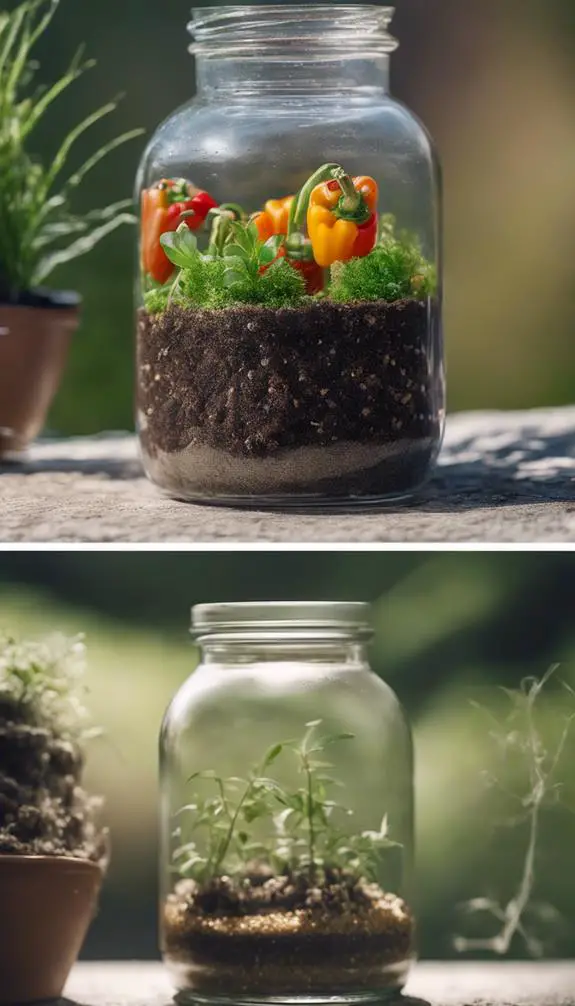
You'll need to create a rooting medium that provides the right environment for your sweet pepper cutting to take root.
To do this, you'll need to mix a blend of ingredients, achieve the perfect soil and water ratio, and sterilize the container to prevent contamination.
Mixing the Medium
Seed starting requires a well-draining, sterile rooting medium that fosters healthy root development.
When mixing your medium, you'll want to combine ingredients that provide the right balance of soil textures. Aim for a mix that's 20-30% peat moss or coconut coir, 20-30% vermiculite or perlite, and 40-50% sterile potting soil.
This blend will offer good water retention, aeration, and drainage. Don't forget to adjust the Medium pH, aiming for a slightly acidic to neutral range of 6.0-7.0.
This will guarantee prime nutrient availability for your sweet pepper seeds. By getting the medium just right, you'll set your seeds up for success and give them the best chance to thrive.
Soil and Water Ratio
Getting the soil and water ratio just right is crucial when creating a rooting medium for your sweet pepper seeds.
Aim for a mix that's not too wet, not too dry. You want the soil to retain water without becoming waterlogged, which can lead to root rot. A general rule of thumb is to create a mix that's 20% water and 80% soil by volume.
This will provide the right balance of moisture and aeration for your seeds to germinate. Also, consider the soil pH, which should be slightly acidic to neutral, ranging from 6.0 to 7.0.
This will guarantee maximum nutrient uptake and healthy root development. By getting the soil and water ratio right, you'll be giving your sweet pepper seeds the best chance to thrive.
Sterilizing the Container
Three key elements come together to create an ideal rooting medium for your sweet pepper seeds: a clean container, a well-balanced soil mix, and proper sterilization.
You'll want to prioritize container safety to prevent the spread of diseases and pests.
To sterilize your container, you can use one of two methods: soaking it in a solution of one part bleach to nine parts water for 10-15 minutes, or washing it with hot soapy water and then rinsing thoroughly.
After sterilization, let the container air dry to prevent any remaining moisture from hindering the germination process.
Planting the Pepper Cutting
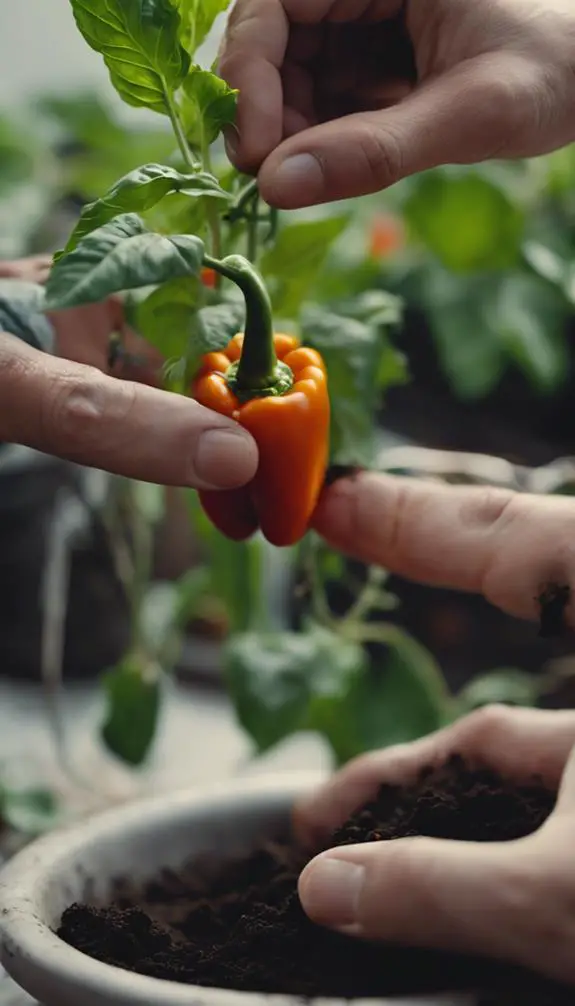
As you prepare to plant the pepper cutting, make sure the rooting medium is moist but not waterlogged, since excessive moisture can cause the cutting to rot before it has a chance to develop roots.
Fill the container with a well-draining pepper soil, and create a small indentation in the center.
Place the cutting in the soil, positioning the stem so that the node (where the leaf meets the stem) is buried and the leaves are above the soil surface.
Gently firm the soil around the stem to secure it in place.
Make sure the soil is snug but not compacted, allowing for proper air circulation and root growth.
Watering and Humidity Control

You'll need to establish a consistent watering schedule to guarantee your sweet pepper plants receive the right amount of moisture.
Monitoring moisture levels is vital, as overwatering can be detrimental to their health, while underwatering can stunt their growth.
Watering Schedule Essentials
Get ready to plunge into the world of sweet pepper cultivation by mastering the art of watering, a crucial aspect of growing these delicious veggies.
You'll need to establish a consistent watering schedule to guarantee your pepper plants receive the right amount of moisture. Watering frequency is key: aim to water your plants when the top 1-2 inches of soil feel dry to the touch.
Scheduling tips include watering in the morning to prevent fungal diseases and avoiding overhead watering, which can wash away beneficial microorganisms.
For peak results, water your pepper plants deeply but infrequently to encourage deep root growth. By following these guidelines, you'll be well on your way to growing healthy, thriving sweet peppers.
Moisture Levels Monitoring
Monitoring moisture levels is crucial to sweet pepper growth, and it involves more than just watering – it's about controlling humidity too.
You'll want to invest in a moisture meter to gauge the soil's water content. This tool will give you precise readings, ensuring you're not over- or under-watering your plants.
Additionally, consider using humidity sensors to track the air's moisture levels. These devices will alert you when the humidity drops or rises, allowing you to adjust accordingly.
Humidity Chamber Creation
By the time your sweet pepper plants reach their mature stages, they'll require a more controlled environment to optimize their growth.
You'll need to create a humidity chamber that provides the ideal climate for your plants. Start by designing a chamber with a clear plastic or glass top to allow for sunlight penetration.
Certify the chamber is airtight to maintain high humidity levels. Install a climate control system that can regulate temperature and humidity levels. You can use a thermostat and humidistat to monitor and adjust the conditions.
Aim for a temperature range of 65-75°F (18-24°C) and humidity levels between 60-80%. With a well-designed humidity chamber, you'll be able to provide your sweet pepper plants with the perfect environment to thrive.
Providing Adequate Light
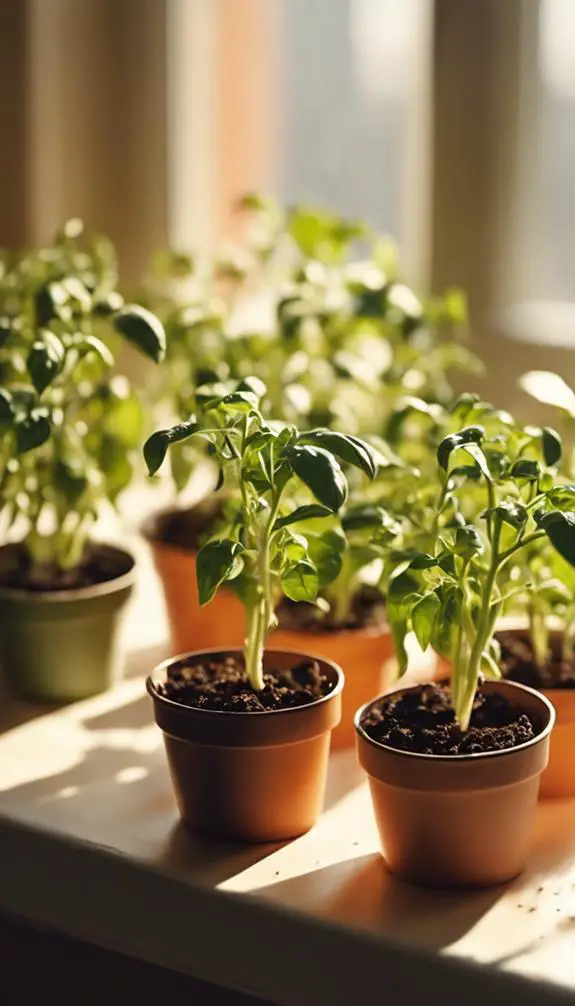
You'll want to provide your sweet pepper plants with an abundance of light to encourage healthy growth and fruit production.
Natural lighting is ideal, so place your plants near a sunny window or under a skylight. If this isn't possible, don't worry – artificial illumination can be just as effective.
Invest in high-quality grow lights, such as LED or HPS lamps, which emit the necessary spectrum and intensity for sweet peppers. Aim for 12-14 hours of light per day, and adjust the distance between the lights and plants as needed.
Maintaining Optimal Temperature

Maintaining Ideal Temperature
Sweet pepper plants thrive in temperatures that are neither too hot nor too cold, and maintaining ideal temperatures is crucial for their development.
You'll want to keep your plants in an area with consistent temperature control, between 65°F to 75°F (18°C to 24°C). This range allows for prime growth and fruit production.
Be cautious of heat stress, which can occur when temperatures exceed 85°F (29°C). High temperatures can lead to scorching, wilting, and reduced fruit set.
To prevent this, guarantee good air circulation and provide shade if necessary. By maintaining ideal temperatures, you'll create a conducive environment for your sweet pepper plants to flourish.
Fertilizing the New Plant

As you settle your sweet pepper seedlings into their new home, it's vital that you provide them with the necessary nutrients to promote healthy growth and development.
You can opt for organic nutrients that are rich in micronutrients, which will enhance the plant's immunity and overall health.
One innovative approach is to use compost tea, a liquid solution made by steeping compost in water.
This nutrient-rich brew will provide your seedlings with a balanced diet of beneficial microbes, promoting strong root development and vigorous growth.
Dilute the compost tea with water according to the recommended ratio, and water your seedlings thoroughly.
This will give them the best possible start in their new environment.
Transplanting the Mature Plant
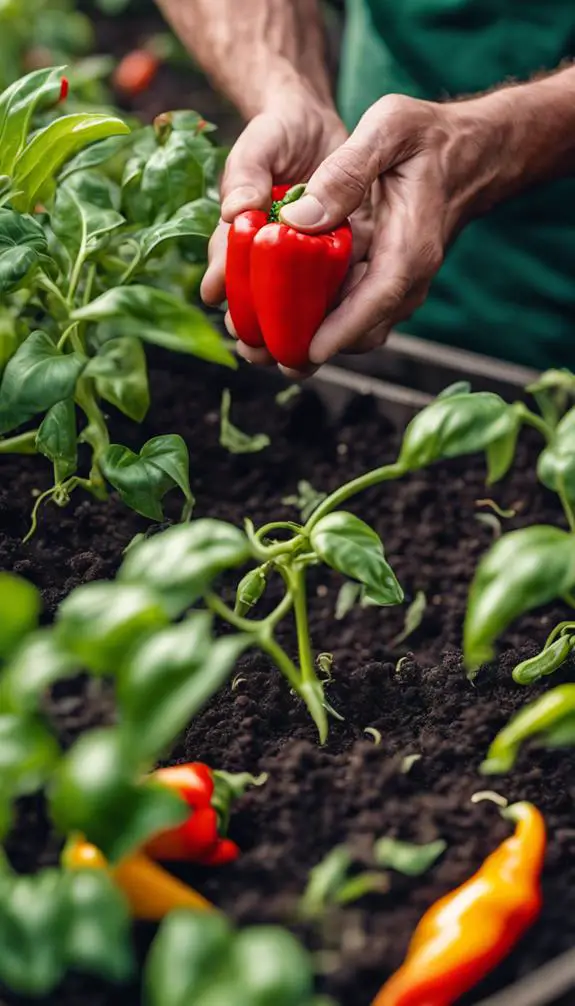
Once your sweet pepper plants have outgrown their containers, it's time to transplant them into a larger space, where they'll have room to spread out and produce a bountiful harvest.
When choosing a new location, consider your garden layout and guarantee the area receives full sun and has well-draining soil. Check the plant hardiness zone to guarantee the sweet peppers will thrive in your local climate.
Dig a hole that's about twice as wide and just as deep as the container. Gently remove the plant from its pot, taking care not to disturb the roots. Place the plant in the hole, backfill with soil, and water thoroughly.
Space the plants about 12-18 inches apart to allow for proper air circulation and growth.
Ongoing Care and Pruning

Throughout the growing season, you'll need to devote some time to ongoing care and pruning to guarantee your sweet pepper plants reach their full potential.
Regular watering, fertilization, and pest management are essential for healthy pepper growth.
Pruning techniques like removing lower leaves, weak growth, and any dead or diseased branches will promote air circulation and direct the plant's energy towards fruit production.
This will encourage bushy growth and prevent the plant from becoming leggy.
By pruning your sweet pepper plants regularly, you'll be rewarded with a bountiful harvest of juicy, sweet peppers.
Remember to prune when the plant is around 6-8 inches tall to encourage a strong stem and healthy root system.
FAQs
Can I Use Pepper Scraps From a Grocery Store to Propagate?
You can try using pepper scraps from a grocery store, but be aware that store quality may vary, and results might not be as reliable as fresh starts from high-quality seeds or seedlings.
How Long Does It Take for Pepper Cuttings to Root?
You'll typically wait 1-3 weeks for pepper cuttings to root, but you can speed up the process by applying root stimulation techniques and providing a hormone boost, which can reduce rooting time to just 7-10 days.
Will Pepper Cuttings Grown From Scraps Produce Identical Peppers?
You'll find that pepper cuttings grown from scraps will likely produce peppers with similar characteristics, but not identical ones, due to genetic variations, unless you're working with a specific, genetically consistent pepper variety.
Can I Propagate Peppers in Water Instead of Soil?
You can successfully propagate peppers in water, developing water roots, and then transfer them to soil or a hydroponic system, using hydroponic starters, allowing for a more controlled and innovative growing experience.
Do Pepper Plants Grown From Scraps Require More Care Than Seedlings?
When growing pepper plants from scraps, you'll find they require more care than seedlings, especially when it comes to soil quality and climate control, as they need precise conditions to thrive, making close monitoring a must.
Conclusion
You've successfully grown sweet peppers from scraps! Now, enjoy the fruits of your labor. With proper care, your new pepper plant will thrive and produce a bountiful harvest. Continue to provide ideal growing conditions, prune regularly to promote healthy growth, and harvest your peppers when they're ripe. Happy growing!


